Golf is more than just a game; it’s a tradition that combines precision, strategy, and a touch of elegance.
As you step onto the lush greens, the right attire not only enhances your performance but also reflects your personal style and respect for the sport. Whether you’re a seasoned pro or a weekend warrior, understanding the nuances of golf attire can elevate your experience and boost your confidence on the course. From breathable fabrics that keep you cool during those intense summer rounds to tailored fits that allow for a full swing, this ultimate guide will take you through the essentials of stylish golf apparel. We’ll explore the latest trends, classic looks, and must-have accessories that will ensure you tee off in style, making a statement while you play your best game. Get ready to transform your golf wardrobe and embrace the perfect blend of comfort, functionality, and flair!
1. Introduction to Golf Attire: Why Style Matters on the Course

Golf is as much a game of precision and skill as it is a showcase of personal style, making the right attire essential on the course. When you step onto the greens, your clothing choices reflect not only your personality but also your respect for the traditions of the game. Golf attire is more than just a uniform; it embodies the spirit and etiquette of this timeless sport.
Dressing appropriately for golf ensures comfort and functionality, allowing you to swing freely and move with ease. Breathable fabrics and moisture-wicking materials keep you cool under the sun, while flexible fits accommodate your movements without restriction. Yet, the importance of style shouldn’t be overlooked. A well-curated golf wardrobe can boost your confidence, making each swing feel a bit more powerful and each putt a touch more precise.
Moreover, a polished appearance can leave a lasting impression on fellow golfers, whether you’re out on a casual Saturday round or participating in a more formal tournament. The right outfit can foster camaraderie and signal your seriousness about the game. Whether you prefer classic polo shirts, tailored shorts, or vibrant accessories, your style choices allow you to express your individuality while adhering to the course’s dress code.
In this guide, we will explore the essentials of golf attire, from fundamental pieces to trendy accessories, ensuring that you not only play your best but look fantastic while doing so. Join us as we delve into the world of golf fashion, where performance meets panache, and discover how to tee off in style.
2. Understanding Golf Dress Codes: Country Clubs vs. Public Courses
When it comes to selecting the perfect golf attire, understanding the dress codes that vary between country clubs and public courses is essential in ensuring you not only look great but also feel comfortable and confident on the course. Golf, often perceived as a sport steeped in tradition, has distinct sartorial expectations depending on where you play.
**Country Clubs:** At a country club, the atmosphere is generally more formal, reflecting the prestigious nature of the venue. Golfers are expected to adhere to strict dress codes to maintain a polished appearance. Men typically wear collared shirts—polo styles are popular—paired with tailored shorts or slacks. Women often opt for stylish golf dresses or skirts, paired with collared or sleeveless tops that have a modest neckline. Footwear should be golf shoes, preferably with soft spikes to protect the greens. Accessories like hats and belts can add a touch of personal style, but it’s important to keep them subtle and tasteful. Many country clubs also have restrictions on denim and t-shirts, so checking the specific guidelines ahead of your visit is crucial.
**Public Courses:** In contrast, public courses tend to have a more relaxed approach to dress codes, welcoming a broader range of styles while still maintaining a level of respect for the game. Here, you might encounter golfers in everything from sporty tank tops and breathable athletic wear to casual shorts and sneakers. While collared shirts are still a safe bet, the focus is on comfort and functionality. Quick-dry fabrics and moisture-wicking materials are ideal for those long days under the sun. Public courses may allow denim, but it’s best to steer clear of overly distressed or baggy styles. Ultimately, while public courses are more lenient, showing a degree of respect for the game and fellow players is always appreciated.
By understanding these distinctions, you can curate your golf wardrobe to suit the specific environment, ensuring that you dress appropriately and play with confidence, whether you’re hitting the greens at a prestigious country club or enjoying a casual round at your local public course.
3. Essential Golf Clothing: Tops, Bottoms, and Layers

When it comes to golf attire, the right clothing can make all the difference in your performance and comfort on the course. The essentials of golf clothing extend beyond mere aesthetics; they play a crucial role in ensuring that you stay cool, dry, and unrestricted as you swing your club.
**Tops**: Start with a solid foundation by selecting breathable, moisture-wicking tops. Polo shirts are a timeless choice, offering both style and functionality. Look for options made from synthetic fabrics that allow for airflow and quick-drying properties. Long-sleeve options are also available for those cooler morning rounds or for added sun protection. Color and pattern matter too—choose hues that reflect your personality while still adhering to any dress codes at your local course.
**Bottoms**: Your choice of bottoms should prioritize both comfort and mobility. Traditional golf shorts, often tailored with a bit of stretch, allow for easy movement while providing a polished look. If you prefer long pants, opt for lightweight, breathable slacks or chinos designed specifically for golf. These should also feature moisture-wicking technology to keep you dry, especially during those hot summer rounds. Remember, it’s essential to check the course’s dress code, as some may have specific requirements regarding length and fit.
**Layers**: Golf is an outdoor sport, and the weather can be unpredictable. Incorporating layers into your outfit is key to staying comfortable throughout your game. A lightweight, zip-up jacket or pullover can be easily added or removed depending on the temperature. Look for options made from breathable materials that allow for movement without added bulk. For particularly chilly days, consider a thermal base layer that fits snugly under your polo without feeling constricting.
By thoughtfully selecting your tops, bottoms, and layers, you can ensure that you not only look good but also feel great while you tee off. Embrace your personal style while prioritizing comfort and functionality, and watch as you elevate both your game and your confidence on the course!
4. Choosing the Right Golf Shirt: Fabrics and Fits
When it comes to selecting the perfect golf shirt, the right fabric and fit can significantly enhance both your comfort on the course and your overall style. Golf is an activity that demands movement and flexibility, so understanding the various materials available is key to making an informed choice.
**Fabrics**
The fabric of your golf shirt plays a crucial role in regulating your body temperature, managing moisture, and providing breathability. Look for materials such as polyester or a polyester blend, which are popular due to their moisture-wicking properties. These fabrics draw sweat away from your skin, keeping you cool and comfortable even on the hottest days. Cotton, while soft and breathable, may not be the best option for a day on the course since it can absorb moisture, leading to discomfort.
Performance fabrics that incorporate spandex or elastane offer an added benefit by providing stretch, allowing for a full range of motion during your swing. Some golf shirts also feature UV protection, which is essential for safeguarding your skin from harmful rays as you spend hours outdoors.
**Fits**
When it comes to fit, there are typically three styles to choose from: classic, athletic, and fitted. Classic fits offer a loose silhouette, providing ample room for movement and a relaxed appearance, making them a great choice for golfers who prioritize comfort. Athletic fits are tailored to contour the body without being restrictive, striking a balance between style and mobility. For those who prefer a more modern look, fitted shirts hug the body closely, emphasizing a sleek profile while ensuring you still have the freedom to swing.
Ultimately, the right golf shirt should not only reflect your personal style but also enhance your performance on the course. Take the time to explore different fabrics and fits to find the combination that feels best for you. After all, looking great while playing your best game is the ultimate goal of any stylish golfer.
5. The Best Golf Pants and Shorts for Comfort and Performance

When it comes to golf attire, the right pants and shorts can make all the difference in your comfort and performance on the course. The best golf pants and shorts are designed with both functionality and style in mind, allowing you to swing freely while looking sharp.
For those sweltering summer days, lightweight, breathable shorts are a must. Look for options made from moisture-wicking fabrics that not only keep you cool but also provide ample stretch for unrestricted movement. Shorts with a tailored fit and subtle patterns can elevate your look while ensuring you stay comfortable during those long rounds. Brands like Nike and Under Armour offer shorts equipped with UV protection, making them perfect for sunny days when the sun is high and the fairways are calling.
As for pants, opt for a pair that combines performance fabrics with a stylish cut. Look for golf trousers that feature four-way stretch, allowing you to bend, twist, and swing with ease. Breathable materials that wick away moisture will keep you feeling fresh, while water-resistant options can protect you from unexpected rain showers.
Color and style also play a critical role in your golf attire. Classic neutrals like navy, khaki, or grey can be easily paired with various polo shirts, while bolder colors or patterns can make a statement on the course. Remember, fit is key; pants and shorts that are too baggy can hinder your movement, while overly tight options can be uncomfortable.
Ultimately, the best golf pants and shorts strike the perfect balance between comfort, performance, and style, ensuring you not only play your best game but also look great doing it. So, before you head out to tee off, make sure your golf wardrobe includes these essential pieces that will keep you at the top of your game.
6. Footwear Fundamentals: Selecting the Right Golf Shoes
When it comes to golf attire, footwear is often an overlooked yet crucial component that can make or break your game. Selecting the right golf shoes is not just about style; it’s about performance, comfort, and stability on the course. With various styles and technologies available, understanding the fundamentals of golf footwear can elevate your experience, both on and off the green.
First, consider the type of golf shoes that best suit your playing style. Traditional spiked shoes offer superior traction, providing grip on uneven terrain and wet grass, which can significantly enhance your swing stability. However, they may not be suitable for all courses, particularly those with a strict no-spike policy. On the other hand, spikeless shoes are gaining popularity for their versatility and comfort, allowing you to transition from the course to the clubhouse with ease while still offering decent traction.
Comfort is paramount when choosing golf shoes since you’ll likely spend several hours on your feet. Look for shoes with cushioned insoles and breathable materials to ensure your feet stay dry and comfortable throughout your game. Additionally, consider the shoe’s fit—opt for a snug fit that allows for some wiggle room for your toes, as this can prevent blisters and discomfort during long rounds.
Don’t forget about the aesthetic aspect, either. Golf shoes come in various styles, from classic leather designs to modern, sporty looks. Choose a pair that reflects your personal style while adhering to any dress codes at your preferred golf club. Many brands now offer shoes that combine performance with fashion, allowing you to confidently step onto the course in style.
Finally, always remember to break in your golf shoes before hitting the course. A few practice swings at the driving range or a casual round can help mold the shoes to your feet, ensuring maximum comfort when it really counts. By prioritizing footwear fundamentals, you’ll not only improve your game but also tee off in style, ready to conquer the course with confidence.
7. Accessories that Elevate Your Golf Style: Hats, Belts, and Gloves

When it comes to golf attire, the right accessories can make all the difference in elevating your style while ensuring comfort and functionality on the course. Hats, belts, and gloves are not just afterthoughts; they are essential components that can enhance your overall look and performance.
**Hats** not only shield you from the sun but also serve as a statement piece that can complement your outfit. Opt for a classic cap or a stylish visors that fits snugly without obstructing your vision. Look for breathable materials that wick away moisture, keeping you cool during those long summer rounds. Choose colors that coordinate with your polo or shorts, or go bold with a patterned design to show off your personality. Remember, a well-chosen hat can add an air of sophistication to even the simplest of ensembles.
**Belts** are another powerful accessory that can tie your entire outfit together. A sleek leather belt can exude elegance, while a colorful woven belt can add a fun twist to your look. Make sure to choose a belt that complements your pants—ideally matching the color or style of your footwear. This small detail can enhance your overall appearance, giving you a polished and put-together look on the green.
**Gloves** are crucial for not only grip but also style. A well-fitted glove can improve your swing while providing a chic touch to your golf attire. Opt for classic white leather gloves for a timeless look, or experiment with vibrant colors and patterns that express your individuality. Ensure that your glove fits snugly without being restrictive, allowing for maximum flexibility as you take your shot.
By carefully selecting these accessories, you can create a cohesive and stylish golf outfit that reflects your personality while keeping you comfortable on the course. After all, golf is as much about style as it is about skill—so why not tee off in style?
8. Seasonal Golf Attire: Dressing for Different Weather Conditions
When it comes to perfecting your golf game, dressing appropriately for the weather can be just as crucial as honing your swing. Seasonal golf attire not only enhances performance but also contributes to comfort and enjoyment on the course. Here’s how to dress for varying weather conditions, ensuring you tee off in style, no matter the forecast.
**Spring and Fall: Layering is Key**
As temperatures fluctuate in the spring and fall, layering becomes your best friend. Start with a moisture-wicking base layer that keeps sweat away while providing warmth. Opt for lightweight long-sleeve shirts or polos made from breathable fabrics. Layer with a stylish golf sweater or vest, which can easily be shed or added as temperatures change. Don’t forget a windbreaker for those breezy days; a tailored jacket in classic colors will keep you looking sharp while protecting you from the elements.
**Summer: Stay Cool and Protected**
In the sweltering summer heat, your primary focus should be on breathability and sun protection. Choose lightweight, short-sleeved shirts crafted from technical fabrics designed to wick moisture and promote airflow. Look for options with UV protection to shield your skin from harmful rays. Pair your shirt with comfortable shorts that allow for a full range of motion; consider those with pockets for storing tees and balls. A stylish wide-brimmed hat and polarized sunglasses will not only enhance your look but also protect your eyes from the glaring sun.
**Winter: Embrace the Elements**
When the temperature drops, it’s time to embrace winter golf attire. Start with thermal base layers that trap heat while remaining lightweight. Layer up with a high-quality golf jacket that is both waterproof and insulated to combat chilly winds and rain. Don’t neglect your extremities; thermal gloves and a beanie can make a world of difference in comfort levels. Opt for pants designed for cold weather—sometimes lined for extra warmth—while ensuring they allow for unrestricted movement during your swing.
By tailoring your golf attire to the seasons, you enhance not only your comfort but also your confidence on the course. Remember, dressing appropriately means you can focus on your game rather than the weather, allowing you to truly enjoy every round. So, whether you’re playing in the golden rays of summer or the crisp air of autumn, make sure to step onto the green looking and feeling your best!
9. Women’s Golf Fashion: Trends and Must-Have Items
When it comes to women’s golf fashion, the landscape is more vibrant and dynamic than ever before. No longer confined to a standard polo and skirt, contemporary women golfers embrace a diverse array of styles that blend functionality with flair. This season, several key trends and must-have items are emerging, ensuring that every woman can tee off in style while remaining comfortable on the course.
**Bold Prints and Patterns:** One of the most exciting trends is the use of bold prints and playful patterns. From floral designs to geometric motifs, women’s golf apparel is increasingly embracing eye-catching aesthetics. These designs not only add a splash of personality to your outfit but also make a statement that sets you apart from the crowd. Look for dresses, skirts, and tops that feature lively prints, as they can elevate your overall look while keeping it fun.
**Technical Fabrics:** Comfort and performance are essential on the golf course, and advancements in fabric technology have made it possible for women to enjoy both. Lightweight, moisture-wicking materials that allow for breathability and flexibility are must-haves in any golfer’s wardrobe. Brands are now offering pieces that blend style with performance, from stretchy leggings to tailored shorts, ensuring that you can move freely while maintaining an elegant silhouette.
**Layering Essentials:** As weather conditions can change rapidly on the course, layering is key. Think chic and functional with lightweight pullovers and stylish vests that can easily be added or removed. Look for options in neutral colors that can seamlessly integrate into your wardrobe while providing that extra layer of warmth when you need it. A well-fitted jacket is also an essential item; opt for one that showcases your personal style without hindering your swing.
**Trendy Footwear:** Footwear has evolved dramatically in women’s golf fashion, with stylish options that don’t compromise on performance. Look for golf shoes that incorporate trendy designs, such as sleek sneakers or slip-on styles, which provide both comfort and grip. Many brands now offer shoes with vibrant colors and patterns, allowing you to find the perfect pair that complements your outfit while providing the support you need for a successful game.
**Accessories that Shine:** Don’t forget to accessorize! From wide-brimmed hats that protect you from the sun to chic visors and statement sunglasses, accessories can enhance your look while serving practical purposes. A stylish golf bag can also add to your overall ensemble, so choose one that reflects your personality and showcases your favorite colors.
Incorporating these trends and must-have items into your golf wardrobe will not only keep you looking fabulous on the course but also boost your confidence with every swing. With the right attire, you’ll be ready to tee off in style, making a statement both in your game and your fashion sense.
10. Men’s Golf Fashion: Timeless Styles and Modern Trends
When it comes to men’s golf fashion, striking the perfect balance between timeless styles and modern trends is essential for both performance and personal expression on the course. Golf attire has evolved significantly over the years, yet several classic elements remain staples that never go out of style.
Classic polo shirts are a quintessential choice, offering a blend of comfort and sophistication. Opt for breathable fabrics that wick moisture away to keep you cool under the sun, while classic colors like navy, white, or soft pastels provide a polished look. Pairing these with tailored golf shorts or slacks can elevate your outfit, ensuring you stay sharp from the first tee to the final putt.
In recent years, golf fashion has seen a resurgence of vibrant patterns and bold colors, allowing players to showcase their personalities. Think stylish floral prints, geometric designs, and bright hues that stand out against the verdant backdrop of the course. Accessories, such as stylish caps or visors, can also add a modern twist, providing protection from the sun while enhancing your overall look.
Footwear is another critical aspect of men’s golf fashion. Traditional spiked shoes have seen a shift towards more casual, sneaker-inspired designs that prioritize both comfort and performance. Look for options that offer excellent grip and support, ensuring you maintain your footing during swings while still looking contemporary.
Finally, don’t underestimate the power of layering. As weather can be unpredictable on the course, lightweight jackets or pullovers can keep you comfortable without sacrificing style. Choose colors that coordinate with your outfit, and opt for materials that allow for ease of movement.
By blending these timeless styles with modern trends, you can create a golf wardrobe that not only meets the demands of the game but also reflects your unique sense of style, helping you tee off in confidence every time you step onto the course.
11. Tips for Maintaining Your Golf Attire: Care and Cleaning
When it comes to golf attire, maintaining your wardrobe is just as crucial as selecting the right pieces to wear on the course. Proper care and cleaning not only extend the life of your clothing but also ensure that you always look sharp and professional, no matter the weather or the number of rounds you’ve played. Here are some essential tips to keep your golf attire in top-notch condition.
**1. Follow Care Labels:** Always check the care labels on your golf shirts, pants, and outerwear. Different fabrics require different care techniques. For example, moisture-wicking materials often need to be washed in cold water to maintain their performance properties, while cotton items can usually withstand a warm wash.
**2. Wash with Care:** To avoid pilling and fading, turn your garments inside out before washing. This simple step protects the outer fabric from friction and helps preserve colors. Use a gentle cycle and mild detergent to keep your attire looking fresh and vibrant.
**3. Avoid the Dryer:** Heat can be particularly damaging to golf clothing, especially those made from synthetic materials. Instead of tossing your gear in the dryer, opt for air drying. Hang your clothes on a rack or lay them flat to maintain their shape and prevent shrinkage.
**4. Store Properly:** Proper storage is key to maintaining the integrity of your golf attire. Avoid cramming your clothes into a crowded closet, as this can lead to creases and wrinkles. Instead, fold or hang garments neatly, allowing them to breathe. Using padded hangers for delicate items can further prevent stretching and distortion.
**5. Spot Clean Stains Promptly:** Golf can be a messy game, and stains are inevitable. Address any spills or marks as soon as possible. Blot the stain gently with a damp cloth, using a mild detergent if necessary. The sooner you tackle the stain, the easier it will be to remove.
**6. Rotate Your Wardrobe:** Just like with your clubs, giving your clothing a break can prolong its life. Rotate your golf attire to avoid excessive wear on any one piece. This also allows you to showcase different styles and keeps your look fresh on the course.
By following these simple care and cleaning tips, you’ll not only keep your golf attire looking great but also ensure that you’re always ready to tee off in style. After all, a well-maintained wardrobe reflects your dedication to the game and your personal style.
12. Brands to Watch: Top Golf Apparel Labels
When it comes to golf attire, the right brand can make all the difference—not just in style, but in performance and comfort on the course. In an age where fashion meets functionality, numerous labels have emerged as front-runners, offering golfers everything from classic looks to cutting-edge innovations. Here are some top golf apparel brands you should keep an eye on as you elevate your golfing wardrobe.
**1. Nike Golf**
Nike Golf blends athletic performance with sleek design, making it a go-to for both amateurs and professionals. Their Dri-FIT technology wicks away moisture, keeping you comfortable even on the hottest days. Look for their signature polos and lightweight outerwear, perfect for layering without sacrificing style.
**2. Adidas Golf**
Adidas Golf is known for its commitment to sustainability, crafting apparel from recycled materials without compromising on style. Their clothing combines modern aesthetics with functional features, such as stretch fabrics for optimal movement. The iconic three stripes make a bold statement, whether you’re on the fairway or at the clubhouse.
**3. Under Armour**
Under Armour offers a range of golf apparel that seamlessly merges sportiness with sophistication. Their lightweight, breathable materials are designed to enhance mobility, making them ideal for those long days on the course. Plus, their stylish golf shoes provide excellent grip and support, ensuring you look and feel great from tee to green.
**4. Puma Golf**
For golfers looking to make a statement, Puma Golf is the brand to watch. Known for its vibrant colors and contemporary styles, Puma offers playful designs that stand out on the course. Their performance gear, complete with moisture-wicking and UV protection features, ensures you remain comfortable while turning heads.
**5. Lululemon**
Though primarily known for yoga apparel, Lululemon has carved out a niche in the golf sector with its stylish and functional pieces. Their focus on high-quality fabrics and flattering fits makes their golf attire a favorite among fashion-forward golfers. Look for their tech shorts and versatile polos that transition seamlessly from the course to casual outings.
**6. Callaway Apparel**
Callaway is synonymous with golf, and their apparel line is no exception. Designed with the golfer in mind, their clothing features innovative technologies that enhance performance, such as moisture-wicking fabrics and stretch materials. Plus, their classic designs ensure you’ll always look polished on the course.
**7. FootJoy**
While FootJoy is best known for its exceptional golf shoes, their apparel line should not be overlooked. Offering a wide range of shirts, shorts, and outerwear, FootJoy combines comfort and style to meet the needs of golfers at all levels. Their commitment to quality ensures that you’ll not only look good but feel great throughout your round.
As you curate your golf wardrobe, keep these brands in mind. Each offers a unique blend of style, comfort, and performance, ensuring you tee off in style while giving your best on the course. Whether you prefer classic elegance or bold statements, there’s a label out there that perfectly matches your golfing aesthetic.
13. Sustainable Golf Attire: Eco-friendly Options for the Conscious Golfer
In recent years, the conversation surrounding sustainability has permeated every facet of our lives, and golf attire is no exception. For the conscious golfer, choosing eco-friendly options not only reflects a commitment to the environment but also enhances the overall experience on the course. The good news is that sustainable golf attire is no longer a niche market; it has become a vibrant and stylish choice for golfers who want to make a positive impact.
When selecting sustainable golf attire, look for brands that prioritize organic materials, such as organic cotton, hemp, and recycled polyester. These fabrics not only reduce the environmental footprint of production but also offer comfort and breathability during those long days on the green. Imagine slipping into a shirt made from soft, organic cotton that feels as good as it looks, allowing you to perform your best while feeling good about your choices.
Moreover, many companies are embracing innovative practices, such as using water-saving dye processes and eco-friendly packaging, which further minimizes their impact on the planet. Some brands even go a step further by incorporating upcycled materials into their designs, transforming discarded textiles into high-quality golf apparel that stands the test of time.
In addition to clothing, consider your accessories. Eco-conscious golfers can now find stylish hats, belts, and shoes made from sustainable materials as well. From biodegradable golf tees to bags crafted from recycled materials, there are endless options to seamlessly blend sustainability with functionality.
By choosing eco-friendly golf attire, you not only enhance your style on the course but also contribute to a growing movement towards responsible consumption. When you step onto the tee box dressed in sustainable fashion, you send a message that you care about the game, the planet, and the future of golf—a choice that other players will surely admire and may even inspire them to follow suit. Embrace the spirit of the game with sustainable choices that reflect your values and set a standard for generations of golfers to come.
14. Creating Your Signature Golf Look: Personal Style Tips
Crafting your signature golf look isn’t just about wearing the latest trends; it’s a chance to express your personality and make a statement on the course. Golf attire has evolved tremendously, merging functionality with style, allowing players to showcase their individuality while adhering to the game’s traditional standards. Here are some personal style tips to help you develop a signature look that stands out while keeping comfort and performance in mind.
Start with the basics: choose well-fitted polo shirts and tailored shorts or slacks that complement your body type. Opt for classic colors, such as navy, white, or muted pastels, which provide a timeless foundation. From there, infuse your personality by incorporating unique patterns or vibrant colors that reflect your character. For instance, if you have a penchant for bold prints, consider a floral or geometric-patterned polo that adds a fun twist while remaining within the boundaries of golf etiquette.
Layering is also essential for those unpredictable weather conditions on the course. A lightweight, stylish jacket can add a sophisticated touch while providing warmth during cooler rounds. Look for options with moisture-wicking properties that will keep you dry and comfortable, regardless of the climate.
Accessories play a crucial role in creating your signature look. A stylish golf cap or visor not only protects you from the sun but can also serve as a fashionable statement piece. Socks are another opportunity to express your style; consider colorful or patterned options that peek out just above your golf shoes, adding a playful element to your overall outfit.
Lastly, don’t forget about your footwear. A sleek pair of golf shoes that combine comfort with style can elevate your look significantly. Choose shoes in classic shades or experiment with bolder designs that pair well with your attire. Remember, the right footwear not only enhances your appearance but also supports your performance on the course.
By thoughtfully combining these elements, you can create a signature golf look that feels authentic to you—one that turns heads as you tee off in style and plays as well as it looks. Your golf attire should empower you to feel confident and comfortable, allowing you to focus on your game while showcasing your unique personality. Happy golfing!
15. Conclusion: Tee Off with Confidence in Your Style
As we conclude our ultimate guide to golf attire, it’s clear that looking good on the course is just as important as playing well. Your clothing choices reflect your personality and can significantly influence your confidence as you tee off. When you feel good in what you’re wearing, it translates into a more enjoyable experience on the green, enhancing your overall performance.
Whether you prefer classic polos paired with tailored shorts or cutting-edge athletic wear that offers both style and function, the key is to find an outfit that resonates with your identity as a golfer. Don’t shy away from expressing your individuality through colors, patterns, and accessories—after all, the golf course is as much a social arena as it is a sporting venue.
Remember, the right attire can also contribute to your comfort and mobility, allowing you to focus on your swing and strategy rather than adjusting your clothing. So as you prepare for your next round, take a moment to assemble an outfit that not only meets the dress code but also makes you excited to step onto the course.
With the insights and tips shared throughout this guide, you’re now equipped to make informed choices that reflect your style while adhering to the traditions of the game. So go ahead—tee off with confidence in your style, and watch as your newfound sartorial flair elevates not just your game, but your entire golfing experience. Happy golfing!
As we wrap up our ultimate guide to golf attire, we hope you feel inspired to step onto the fairway with confidence and style. Whether you’re a seasoned pro or a weekend warrior, the right clothing can enhance not just your performance but also your enjoyment of the game. From moisture-wicking fabrics to stylish accessories, every choice you make contributes to your unique golfing identity. Remember, looking good often translates to feeling good, so don’t shy away from expressing your personality through your golf attire. Now, it’s time to hit the greens and showcase your newfound knowledge—tee off in style and make every round a perfect blend of comfort and fashion!




































